Introduction
Selecting the right design agency in New York can feel overwhelming, given the vast array of choices. Each agency presents its own unique strengths, yet aligning these capabilities with a brand's specific needs is essential for achieving success. This guide outlines the critical steps to navigate the selection process, ensuring that brands not only discover a partner that resonates with their vision but also one equipped to effectively address their challenges.
So, how can brands ensure they make the best choice amid such diversity? What key factors should they prioritize to cultivate a fruitful collaboration? Let's delve into these questions and empower your decision-making process.
Define Your Brand's Unique Needs and Goals
Start by conducting a comprehensive assessment of your company's current market position. Address these critical questions:
- What are the primary objectives of this project? (e.g., rebranding, launching a new product, increasing market visibility)
- Who is your target audience, and what are their preferences?
- What challenges is your company currently facing?
- What is your budget for this project?
Documenting these insights will create a clear brief that outlines your company's unique needs and goals. This reference point is essential during the selection process, ensuring you remain focused on identifying a firm that can effectively meet these specific requirements. A well-defined evaluation not only clarifies your goals but also enhances your ability to communicate effectively with prospective partners, ultimately leading to a more successful collaboration. As branding specialists emphasize, aligning your selection with your brand's strategic objectives is crucial for achieving desired results and elevating your marketing efforts.
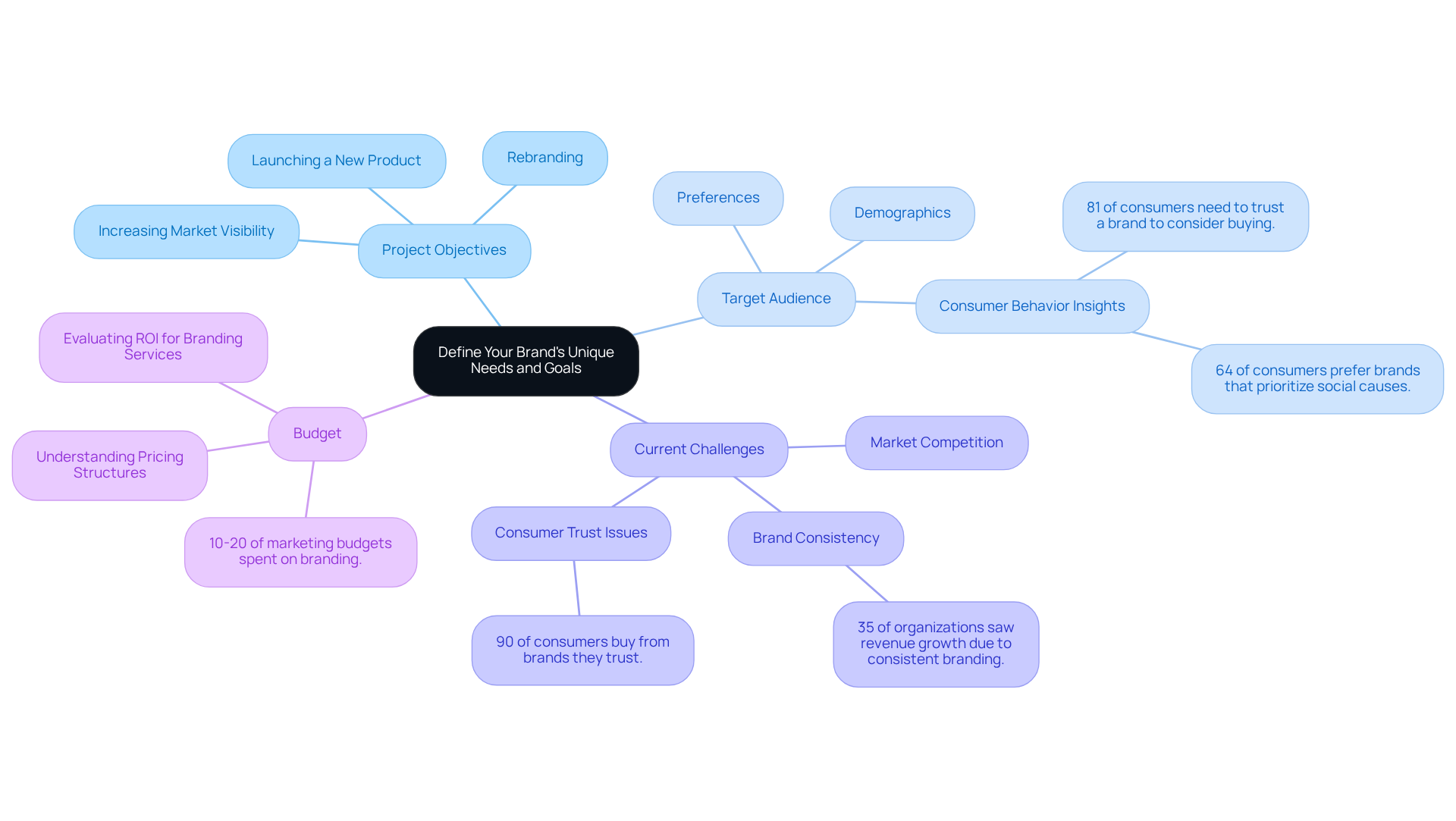
Research and Evaluate Design Agencies in New York
Begin your research by compiling a comprehensive list of New York design agencies. Utilize a variety of resources, including:
- Online directories like Clutch and DesignRush
- Social media platforms such as LinkedIn and Instagram
- Industry publications and blogs that showcase agency work
Once your list is ready, evaluate each agency based on the following criteria:
- Specialization: Identify whether they concentrate on areas like branding, web design, or UX/UI.
- Client Reviews and Testimonials: Seek feedback from past clients to assess satisfaction and effectiveness. For example, Dennis Krupka, Jr. from Benjamin Moore commended Overskies for their enthusiasm and dedication to delivering high-quality, on-brand products. Similarly, Jennifer Fink from Citizen praised their collaborative approach and ability to enhance market positioning with each new launch.
- Awards and Recognitions: Take into account agencies that have earned accolades for their work, as this often signifies quality and innovation.
- Case Studies: Examine their portfolio to find examples of successful projects that resonate with your branding needs.
Narrow your options down to a shortlist of firms, including a New York design agency, that align with your vision and values, ensuring they have a proven track record in your industry. Keep in mind that up to 70% of a campaign’s effectiveness is directly tied to the quality of its creative content, making the selection of the right firm crucial. As Jack Shepherd, Co-Founder & Marketing Director, notes, "The chemistry between your team and the firm's team is essential to attaining the best outcomes for your brand.
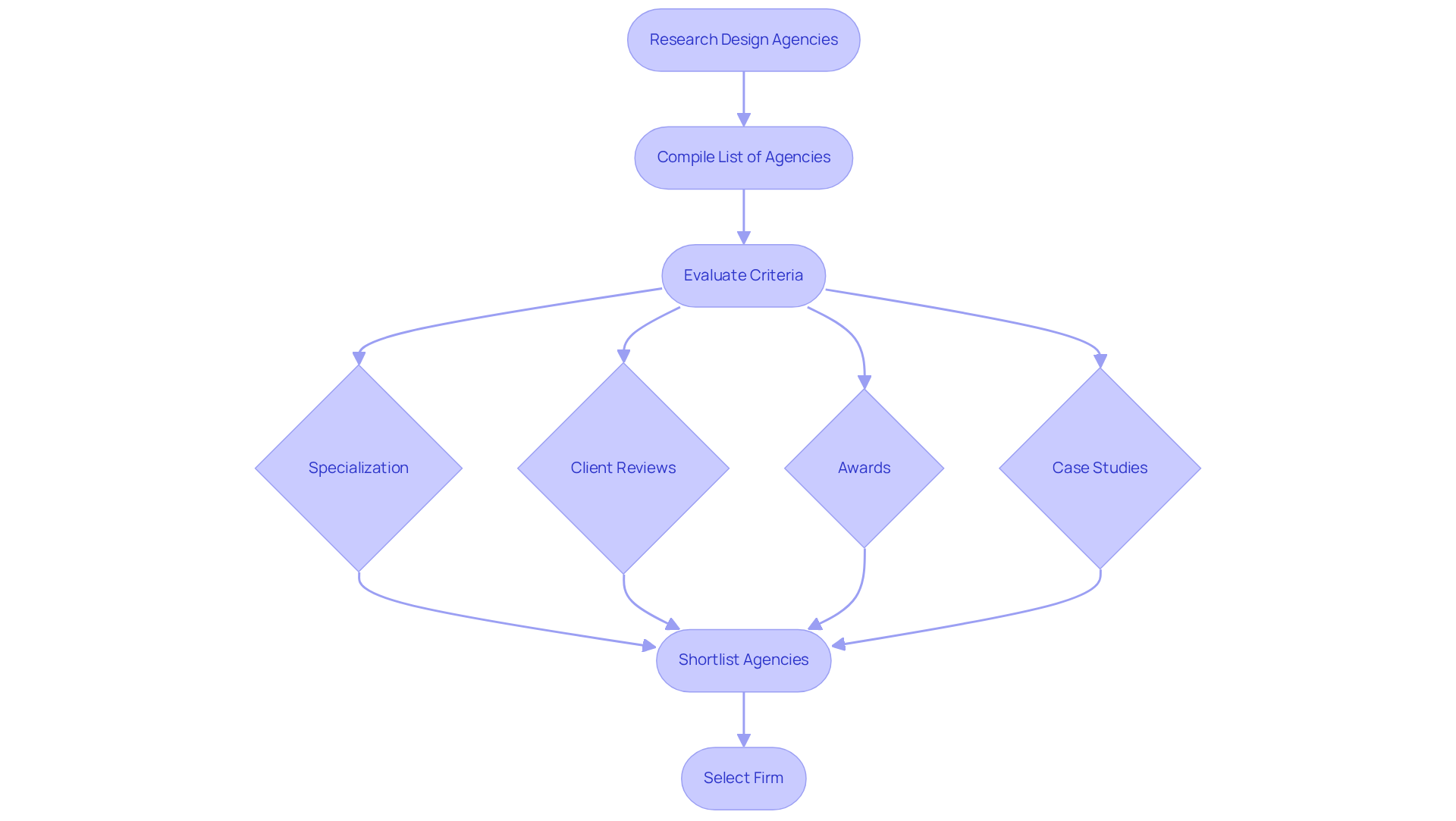
Assess Agency Expertise and Portfolio Alignment
When evaluating potential design firms, a thorough review of their portfolios is essential. Focus on these key areas:
- Diversity in Work: Seek agencies that showcase a broad range of experience across various industries and project types. A diverse portfolio indicates adaptability and a wealth of creative solutions.
- Quality of Design: Assess the creativity, attention to detail, and overall aesthetic of their works. High-quality design reflects the firm's commitment to excellence and can significantly influence your brand's perception.
- Relevance to Your Needs: Determine if the organization has effectively completed projects similar to yours or within your field. Relevant experience enhances their understanding of your specific challenges and goals.
Moreover, engage with these organizations to request case studies that highlight their problem-solving abilities and the concrete outcomes achieved for prior clients. These insights will deepen your understanding of their expertise and how they can effectively contribute to your brand's success.
In conclusion, a meticulous evaluation of design firms not only aids in selecting the right partner but also sets the foundation for a successful collaboration that can elevate your brand.
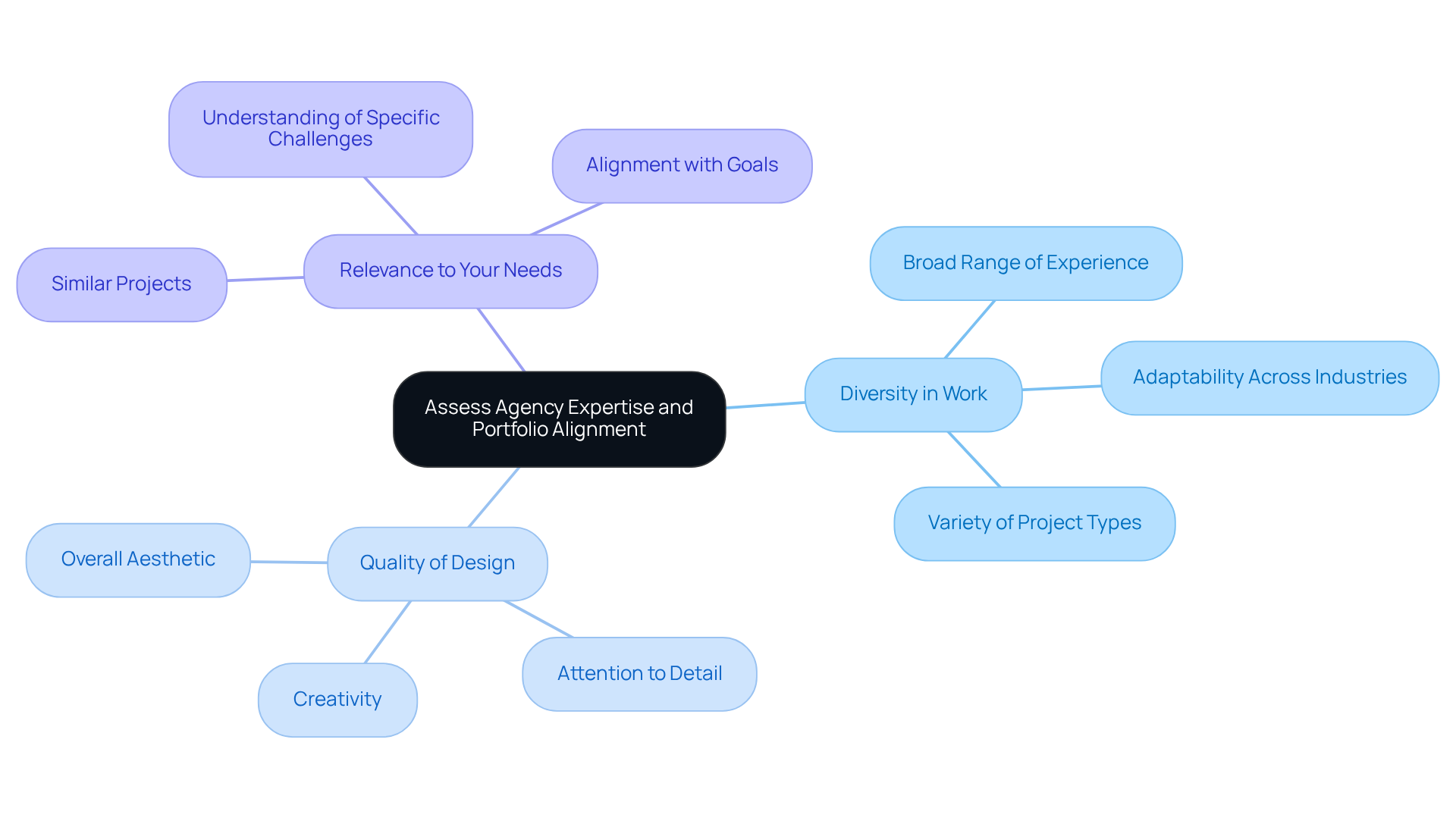
Establish Clear Communication and Collaboration Expectations
After selecting an agency, conducting a kickoff meeting is essential to outline the key elements of the partnership. Focus on these critical aspects:
- Project Goals and Timelines: Clearly define what success looks like and establish realistic deadlines.
- Roles and Responsibilities: Specify the duties of both teams to avoid confusion and ensure accountability.
- Preferred Communication Channels: Decide on the most effective methods for communication, whether through email, management tools, or other platforms.
- Frequency of Check-ins and Updates: Determine how often both teams will touch base to discuss progress and address any issues.
Promoting open conversation and constructive criticism throughout the endeavor is vital for sustaining alignment and swiftly addressing challenges. By establishing these expectations from the outset, you lay the groundwork for a productive and successful collaboration. Remember, workplaces with effective communication strategies enjoy 4.5 times higher employee retention, underscoring the importance of clear communication in maintaining strong agency-client relationships.
At Overskies, we prioritize a human-first approach, recognizing that our clients and their customers are people, not just data points. This ethical perspective fosters trust and collaboration, enhancing the overall effectiveness of our communication strategies. Additionally, understanding the challenges faced by B2C organizations in the current retail landscape allows us to tailor our strategies effectively. Utilizing a client portal can also enhance communication efficiency, providing a centralized platform for updates and feedback.
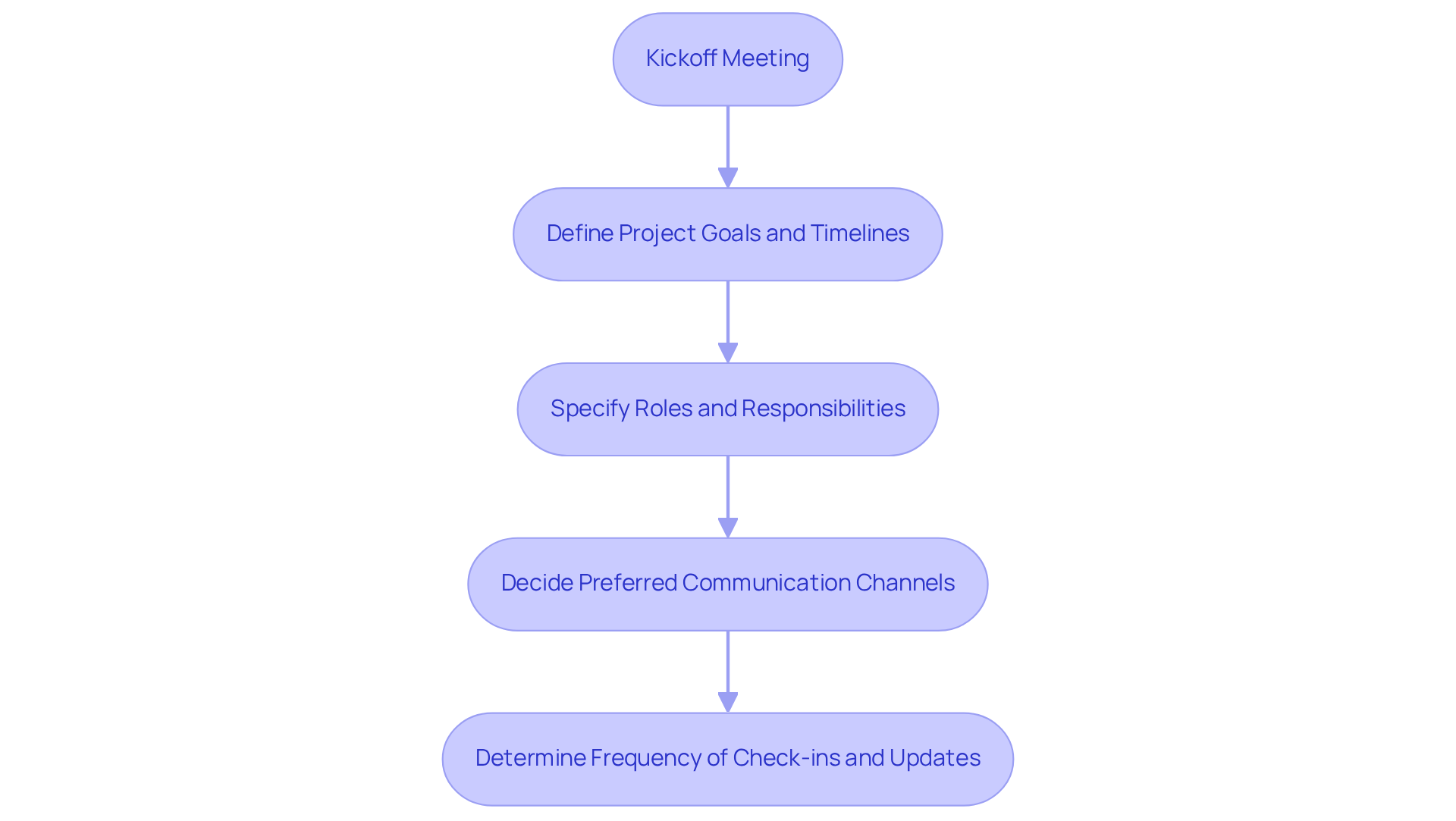
Finalize Your Selection and Initiate the Partnership
Once you've selected your agency, solidify the partnership by taking these essential steps:
-
Review and Sign Contracts: Ensure that contracts clearly define the project scope, deliverables, timelines, and payment terms. This clarity helps prevent misunderstandings and sets the foundation for accountability.
-
Define Shared Goals: Collaboratively establish shared goals that align with your brand's priorities. This alignment is crucial for ensuring that the partnership is focused and effective, much like Overskies' approach to understanding client ambitions and challenges.
-
Implement a Management System for Projects: Establish a robust management system to monitor progress and streamline communication. This tool is essential for tracking milestones and ensuring that all parties are aligned throughout the lifecycle, reflecting Overskies' commitment to measurable impact and collaboration.
-
Set Performance Benchmarks: Clearly outline realistic performance benchmarks and communicate timelines to keep both teams focused on outcomes. This practice helps in measuring success and adjusting strategies as needed, echoing Overskies' dedication to celebrating shared achievements.
-
Schedule Regular Check-Ins: Plan consistent meetings to review project milestones and address any emerging issues. These check-ins promote transparency and teamwork, enabling both groups to adjust to changes and share achievements together, strengthening the trust and relationship that Overskies values.
By following these steps, you will lay the groundwork for a successful partnership that effectively advances your brand's objectives, mirroring the enduring relationships Overskies has built with its clients over the years.
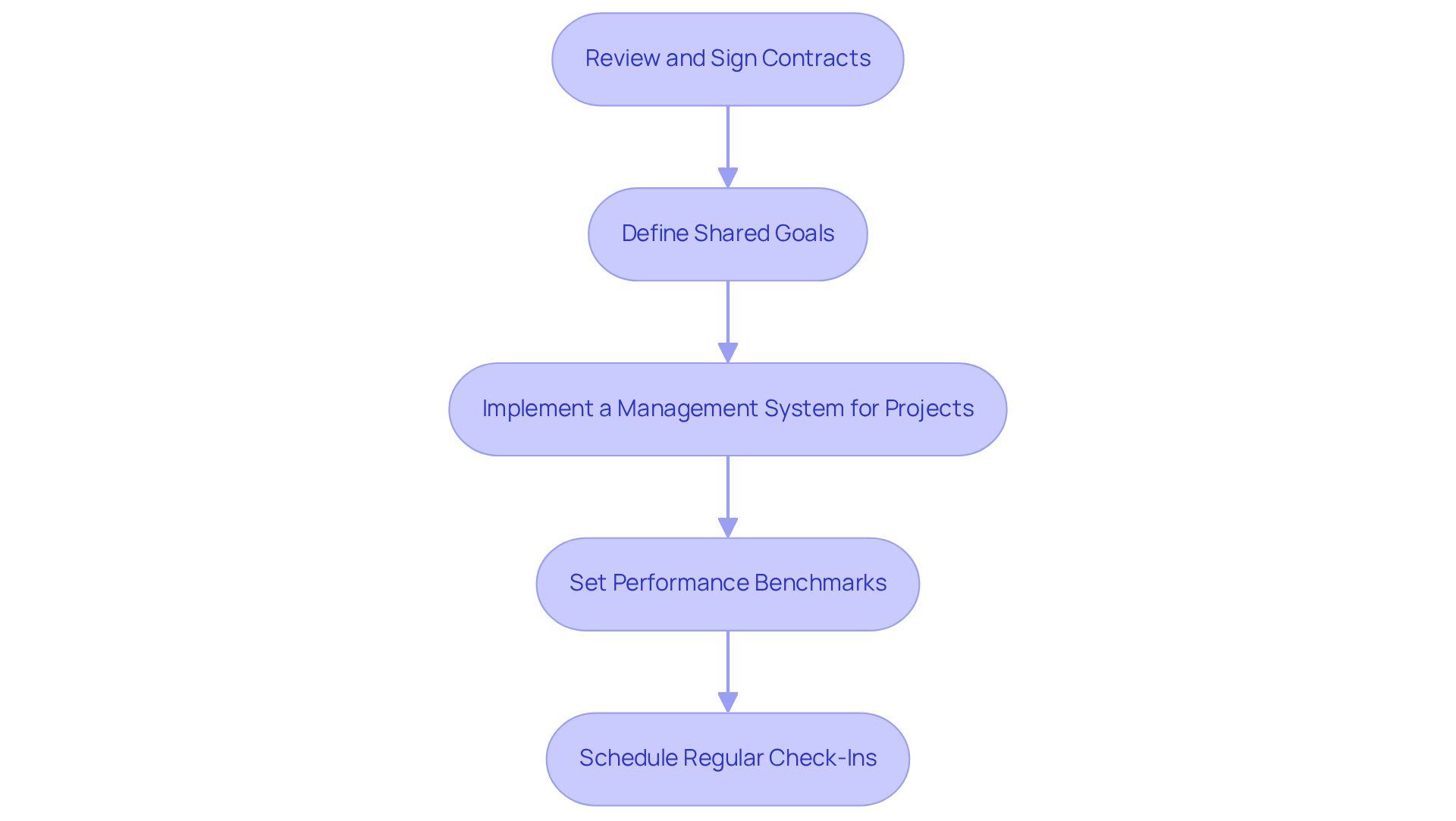
Conclusion
Choosing the right design agency in New York is a pivotal step in ensuring that a brand's unique needs and goals are effectively met. By following a structured approach—defining specific objectives, researching potential agencies, assessing expertise, establishing communication expectations, and finalizing the partnership—brands can significantly enhance their chances of success. This process not only helps in identifying a suitable agency but also fosters a collaborative environment essential for achieving desired outcomes.
Key insights from this guide underscore the importance of thoroughly evaluating design agencies based on:
- Specialization
- Client feedback
- Portfolio relevance
- The quality of their work
Establishing clear communication and collaboration expectations from the outset lays a strong foundation for a productive relationship. Moreover, emphasizing shared goals and regular check-ins ensures both parties remain aligned and focused on achieving measurable results.
Ultimately, investing time and effort in selecting the right design agency is paramount. This decision influences not just the immediate project but also the long-term perception and success of the brand. By prioritizing a strategic and thoughtful selection process, brands can secure a partnership that not only meets their current needs but also propels them toward future growth and innovation. Take action now—your brand's future depends on it.
Frequently Asked Questions
What are the first steps to define my brand's unique needs and goals?
Start by conducting a comprehensive assessment of your company's current market position by addressing key questions such as the primary objectives of the project, target audience preferences, current challenges, and budget.
Why is it important to document insights about my brand's needs and goals?
Documenting these insights creates a clear brief that serves as a reference point during the selection process, ensuring you remain focused on identifying a firm that can effectively meet your specific requirements.
How should I begin researching design agencies in New York?
Compile a comprehensive list of New York design agencies using resources like online directories (Clutch, DesignRush), social media platforms (LinkedIn, Instagram), and industry publications or blogs that showcase agency work.
What criteria should I use to evaluate design agencies?
Evaluate agencies based on specialization, client reviews and testimonials, awards and recognitions, and case studies that demonstrate successful projects relevant to your branding needs.
How can I narrow down my options for design agencies?
After evaluating potential agencies, narrow your options down to a shortlist of firms that align with your vision and values and have a proven track record in your industry.
What role does creative content play in the effectiveness of a campaign?
Up to 70% of a campaign’s effectiveness is directly tied to the quality of its creative content, making the selection of the right firm crucial for achieving desired results.
Why is the chemistry between my team and the design agency's team important?
The chemistry between your team and the agency's team is essential for attaining the best outcomes for your brand, as it fosters collaboration and understanding throughout the project.
.png?width=250&height=153&name=CSI-OverskiesRebrand_LOGO-01(smaller).png)

.png?width=100&height=61&name=CSI-OverskiesRebrand_LOGO-01(smaller).png)


.png?width=88&name=CSI-OverskiesRebrand_LOGO-01(smaller).png)



